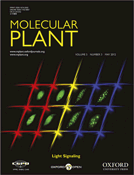In non-cyanogenic species, the main source of cyanide derives from ethylene and camalexin biosyntheses. In mitochondria, cyanide is a potent inhibitor of the cytochrome c oxidase and is metabolized by the β-cyanoalanine synthase CYS-C1, catalyzing the conversion of cysteine and cyanide to hydrogen sulfide and β-cyanoalanine. The hydrogen sulfide released also inhibits the cytochrome c oxidase and needs to be detoxified by the O-acetylserine(thiol)lyase mitochondrial isoform, OAS-C, which catalyzes the incorporation of sulfide to O-acetylserine to produce cysteine, thus generating a cyclic pathway in the mitochondria. The loss of functional OAS-C isoforms causes phenotypic characteristics very similar to the loss of the CYS-C1 enzyme, showing defects in root hair formation. Genetic complementation with the OAS-C gene rescues the impairment of root hair elongation, restoring the wild-type phenotype. The mitochondria compromise their capacity to properly detoxify cyanide and the resulting sulfide because the latter cannot re-assimilate into cysteine in the oas-c null mutant. Consequently, we observe an accumulation of sulfide and cyanide and of the alternative oxidase, which is unable to prevent the production of reactive oxygen species probably due to the accumulation of both toxic molecules. Our results allow us to suggest that the significance of OAS-C is related to its role in the proper sulfide and cyanide detoxification in mitochondria.
Artículo del mes
Mitochondrial Sulfide Detoxification Requires a Functional Isoform O-Acetylserine(thiol)lyase C in Arabidopsis thaliana
Consolación Álvarez, Irene García, Luis C. Romero, Cecilia Gotor
Molecular Plant, 2012, Vol. 10, 1217-1226IBVF



 English
English